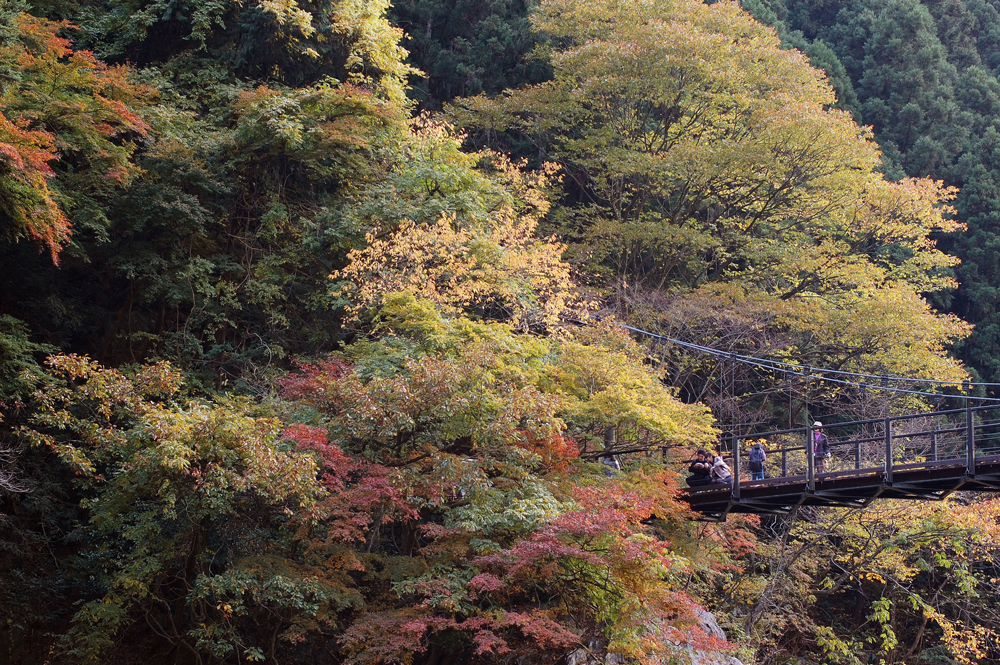NIKKOR - The Thousand and One Nights No.44

Nikkor-S Auto 50mm F1.4
I first became interested in photography and cameras in the 1970s when 50mm f/1.4 lenses were the standard normal lenses for single-lens reflex cameras. Naturally, manufacturers offered slightly slower 50mm f/2 and 55mm f/1.8 lenses, but they were positioned as lower-priced versions of f/1.4 lenses. Where the user's budget allowed, f/1.4 lenses were preferred and even recommended by camera shops.
Many may have forgotten that this was the time of Leica's popular rangefinder cameras, when normal lenses generally had a maximum aperture of f/3.5 or f/2.8, or f/2 a little later on. While faster f/1.5 lenses were also available, they were considered specialty lenses for shooting in dark situations. So, why did f/1.4 lenses become the standard for normal lenses in the age of SLR cameras?
by Kouichi Ohshita
Perhaps one of the reasons lies in the structure of SLR cameras, with which the view through the lens is projected in the viewfinder. Compared to today's SLR viewfinders, viewfinders on early SLR cameras were extremely dark making fast lenses necessary to preserve viewfinder brightness. In addition, we cannot overlook the fact that with the switch to SLR, camera bodies became larger allowing larger lenses to be used in terms of overall balance. However, these reasons alone are not sufficient. The primary reason is that, in addition to their superior performance at maximum aperture, f/1.4 lenses had been developed to offer performance equal to that of slower lenses when the aperture was stopped down.
Many readers surely recognize the fact that faster lenses mean better performance. This awareness generally holds with today's lenses. Faster lenses, or those with larger maximum apertures, allow users to take advantage of bokeh, yet offer performance equal to that of slower lenses when the aperture is stopped down. Personally, I recommend the fastest lenses a user's budget will allow.
However, in terms of lens design, it was not certain that a faster lens would offer the level of performance needed to make it an all-purpose lens. This is because faster lenses require more lens elements. In addition to increasing ghost and flare, more lens elements also make it difficult to maintain balanced performance at maximum aperture and when the aperture is stopped down. Therefore, with "classic" fast lenses, performance when the aperture was stopped down (maximum aperture is probably not used with many scenes) was often inferior to that of slower lenses. Of course there were also battles for lens size and price, but this performance issue was that reason that fast lenses were positioned as specialty lenses.
The Nikkor-S Auto 50mm f/1.4 introduced in tonight's tale did away with the shortcomings of previous fast lenses, making f/1.4 lenses the standard for normal lenses.
I. The Nikkor-S Auto 50mm f/1.4

Nikon was not completely satisfied with the Nikkor-S Auto 5.8cm f/1.4 released in 1960. One reason was that the focal length deviated slightly from the "5.8cm = 58mm" standard. As 55mm focal lengths were very common for SLR normal lenses at the time, a focal length indicated as 5.8cm was probably not so poorly received. However, as a rather new camera manufacturer, it was imperative that Nikon achieve a 50mm normal lens in order to distinguish itself from other manufacturers. This determination to develop a 50mm lens can be seen in the structure of the Nikkor-S Auto 5cm f/2, which utilized a slightly concave lens for the front lens element in order to preserve back focus.
In terms of performance as well, further improvements were necessary.
As mentioned in Tale 40, the Nikkor-S Auto 5.8cm f/1.4 suffered in comparison to the Nikkor-S Auto 5cm f/2 due to inferior resolution caused by the persistence of coma flare visible at the center of images and curvature of field.
Development of the 50mm f/1.4 began with the determination that these issues be overcome. The lens was designed by Zenji Wakimoto and Yoshiyuki Shimizu. Design began around 1959 when Wakimoto completed design of the Nikkor-H Auto 28mm f/3.5. Finally, after three full years of work, the Nikkor-S Auto 50mm f/1.4 was completed. Photo 1 shows the lens and Figure 1 shows the lens configuration.
If we compare Nikkor-S Auto 50mm f/1.4 lens configuration to that of the Nikkor-S Auto 5.8cm f/1.4 introduced in Tale 40, we see that the 50mm f/1.4 lens was constructed with one less convex meniscus element in the front lens group and one more convex meniscus element in the rear group. Perhaps the idea for utilizing two convex elements in the rear lens group resulted from the design of the 28mm f/3.5. Coma correction was also difficult for retrofocus wide-angle lenses. However, coma correction was increased significantly by making the last two lens elements convex, as was done with the 28mm f/3.5. It is certain that Wakimoto believed that this same sort of configuration could be applied to the longer back focus Gauss design. Wakimoto was correct in his assumption, and the coma so prevalent at the center of images and curvature of field were significantly reduced. While there was still more flare at maximum aperture than with the slightly slower Nikkor-S Auto 5cm f/2, this was the moment that an f/1.4 lens offering performance equal to that of slower lenses when the aperture was stopped down was finally achieved.
II. Improved production
There was yet another epoch-making aspect to the development of this lens. Pot correction was no longer performed.
Lenses were once produced by melting optical glass in a pot. The glass was made by combining the ingredients of the glass, placing them in a pot, and then melting them at a high temperature. When melting a particular type of glass, ingredients were combined to produce the same refractive index, but variations between batches inevitably occurred. Lens designers performed simulations based on the variations in refractive index between different batches of glass. Next, design correction to modify the radius of curvature was implemented for each batch of glass to prevent variations in performance and focal length from design values. Nikon refers to this verification and correction design as "pot correction." As designs had to be revised for each batch of glass, this placed a heavy burden on both designers and factories in charge of production.
By the 1960s, the amount of glass being produced had increased and variations in production had decreased significantly. Nikon took this opportunity to define the acceptable refractive index (tolerance) of each glass ingredient and determined to use only the ingredients that resulted in the acceptable refractive index for this lens, for which production volume was large, doing away with performance verification and changes to radius of curvature through simulations. By abolishing the pot correction method, lens productivity was increased significantly and more stable production was made possible.
This achievement represented a major step forward by basically switching from a hand-made production method to an industrial one.
III. Lens performance

Nikon D40 with Nikkor-S Auto 50mm
f/1.4: 1/4 s, f/2, ISO 200, AWB

Nikon D40 with Nikkor-S Auto 50mm
f/1.4: 1/30 s, f/4, ISO 200, AWB

Nikon D40 with Nikkor-S Auto 50mm
f/1.4: 1/250 s, f/4, ISO 200, "Direct sunlight" WB
Finally, let's take a look at the rendering capability of this lens with aberration simulations and actual photos.
The rendering capability of this lens is probably best described as typical of a normal lens. It offers consistently good performance at all aperture values. While spherical aberration is greater and contrast at the center of the frame is somewhat less at maximum aperture than with the 5.8cm f/1.4 introduced in Tale 40, there is much less coma flare throughout the entire frame for a sharper overall image.
Example 1 is a night landscape photo shot with the aperture stopped down to f/2. Even when a DX-format camera is used, a slight amount of coma flare is visible at frame peripheries with shooting at f/2. This flare is further reduced by stopping down the aperture to f/2.8, and nearly eliminated throughout the frame at f/4 for extremely sharp rendering.
While the sense of the season is somewhat lacking, Example 2 is a shot of autumn leaves captured with the aperture stopped down to f/4. I'm sure you can see just how consistently sharp the entire image is throughout the full imaging range of the DX image sensor. As only a single layer of coating is used with this lens, backlit scenes, scenes captured on cloudy days and stray light often result in somewhat flat images.
To achieve more vivid and dynamic images, a hood should definitely be used to prevent flare.
Example 3 is a photo of hollyhocks growing on a beach. One drawback of this lens that should be mentioned is the rather unexceptional bokeh at maximum aperture. With a significant degree of spherical aberration, background bokeh tends to be ring shaped, peripheral bokeh is distorted into a rugby ball shape due to optical vignetting, and bokeh sometimes gives the impression of rotational background motion. As with this example, try stopping the aperture down to f/4 to resolve these issues and achieve more pleasing bokeh.
Released in 1962, this lens became just as popular as Nikon had hoped it would and established its position as a standard normal lens for Nikon F cameras.
It was produced in its original form for 14 years until multi-layer coatings were adopted in 1972 and its optical system was improved in 1976. The Nikkor-S Auto 50mm f/1.4 was the most popular NIKKOR lens during the Nikon F and F2 eras.

NIKKOR - The Thousand and One Nights
The history of Nikon cameras is also that of NIKKOR lenses. This serial story features fascinating tales of lens design and manufacture.

